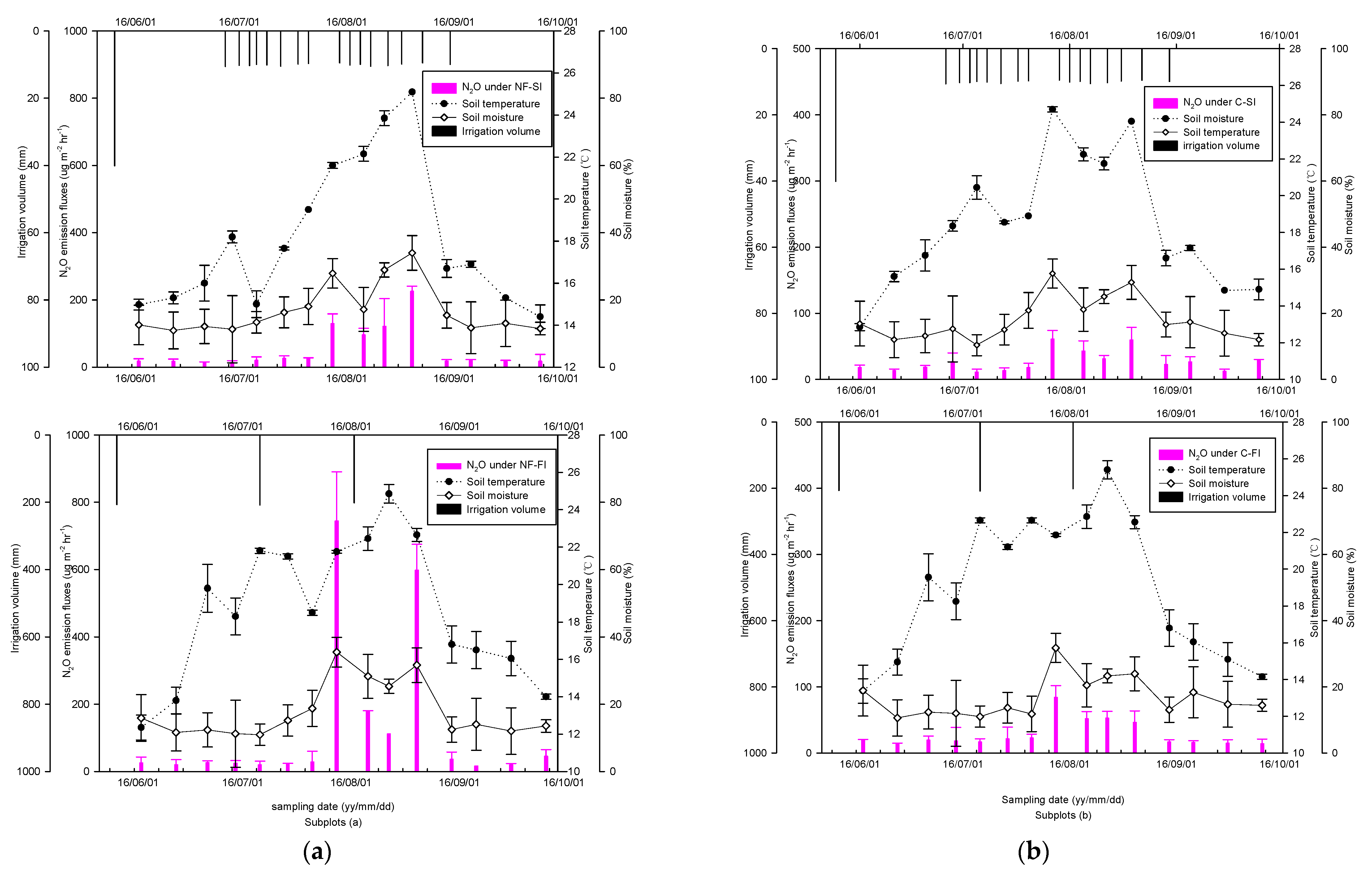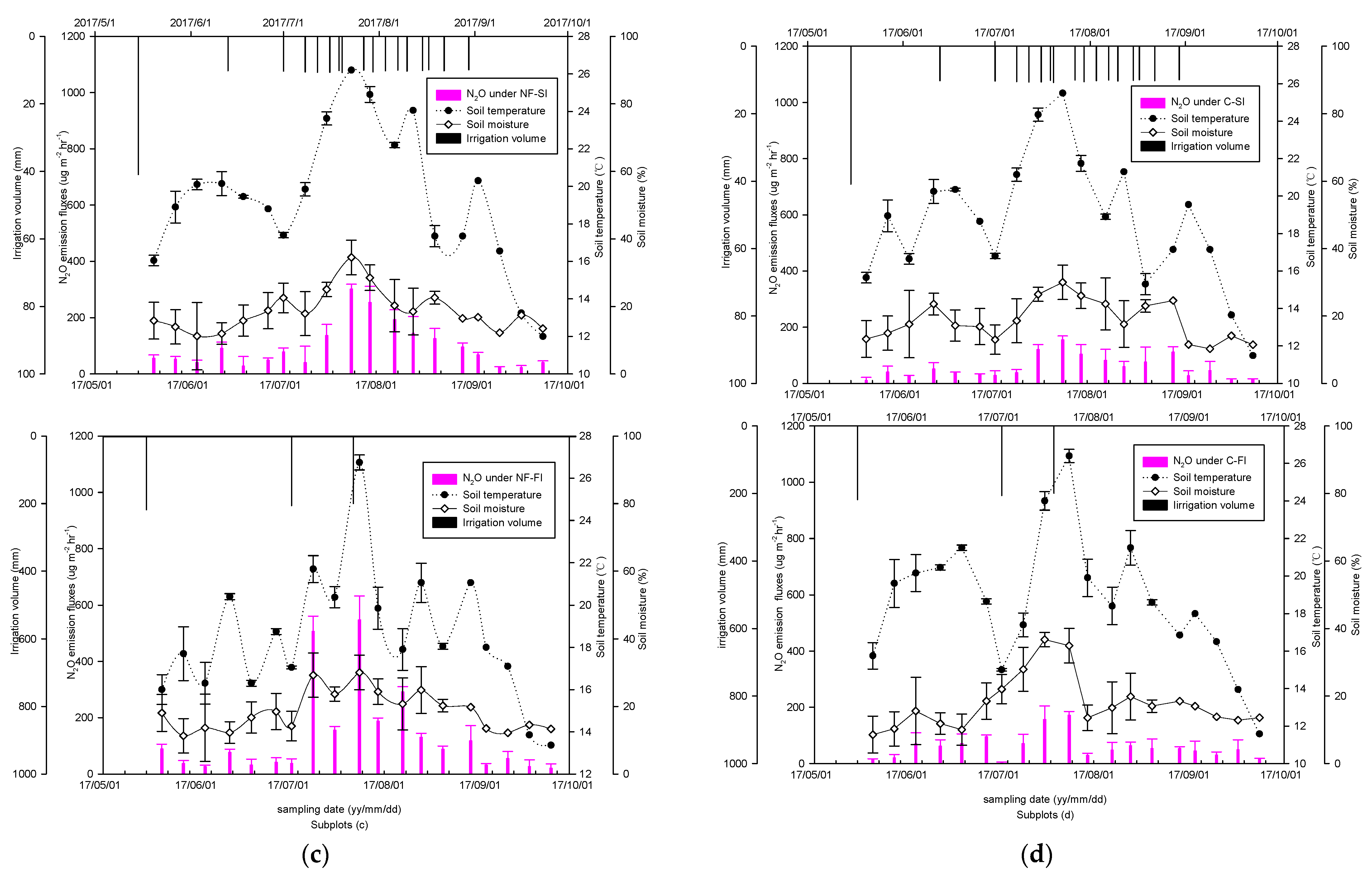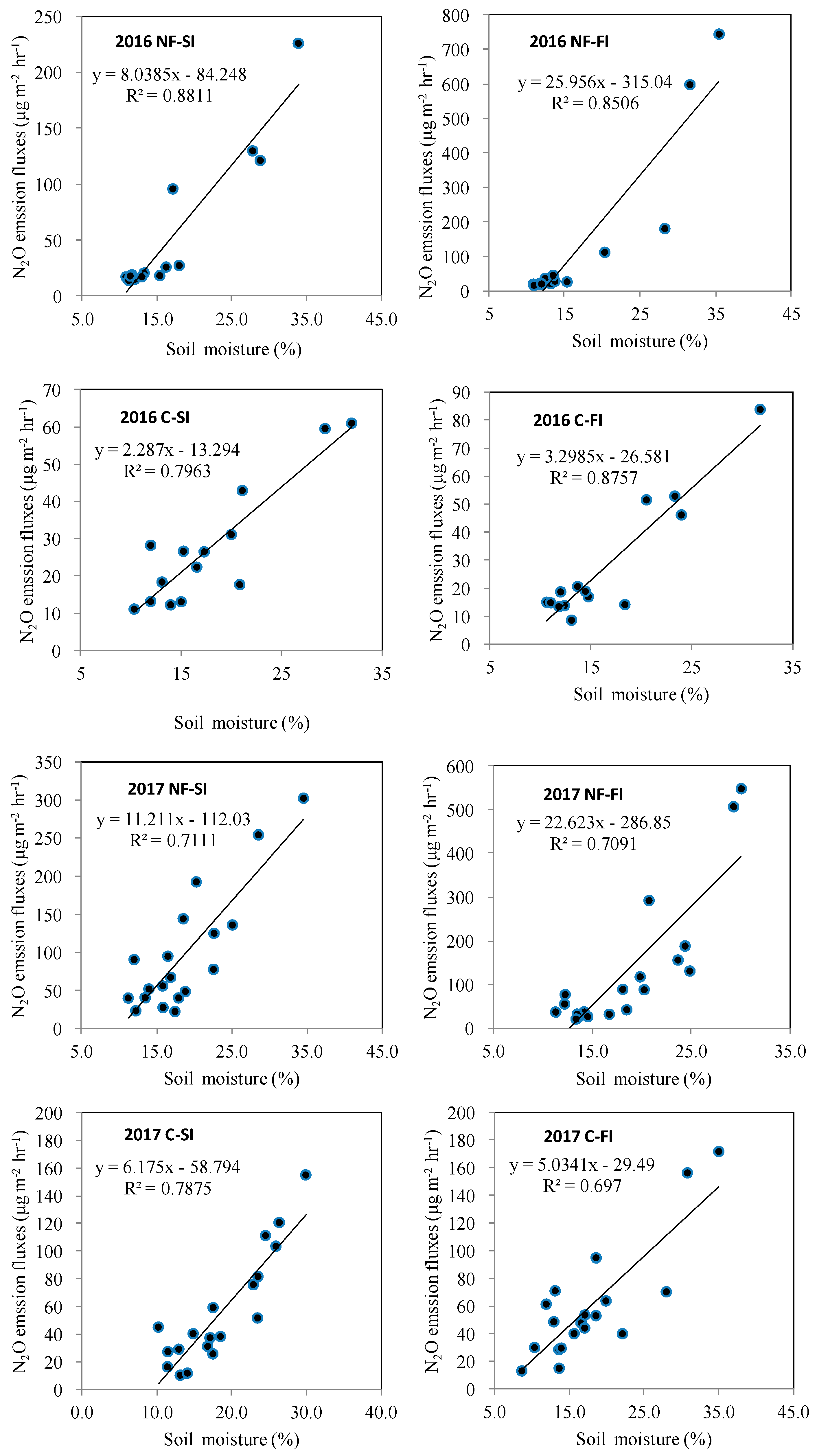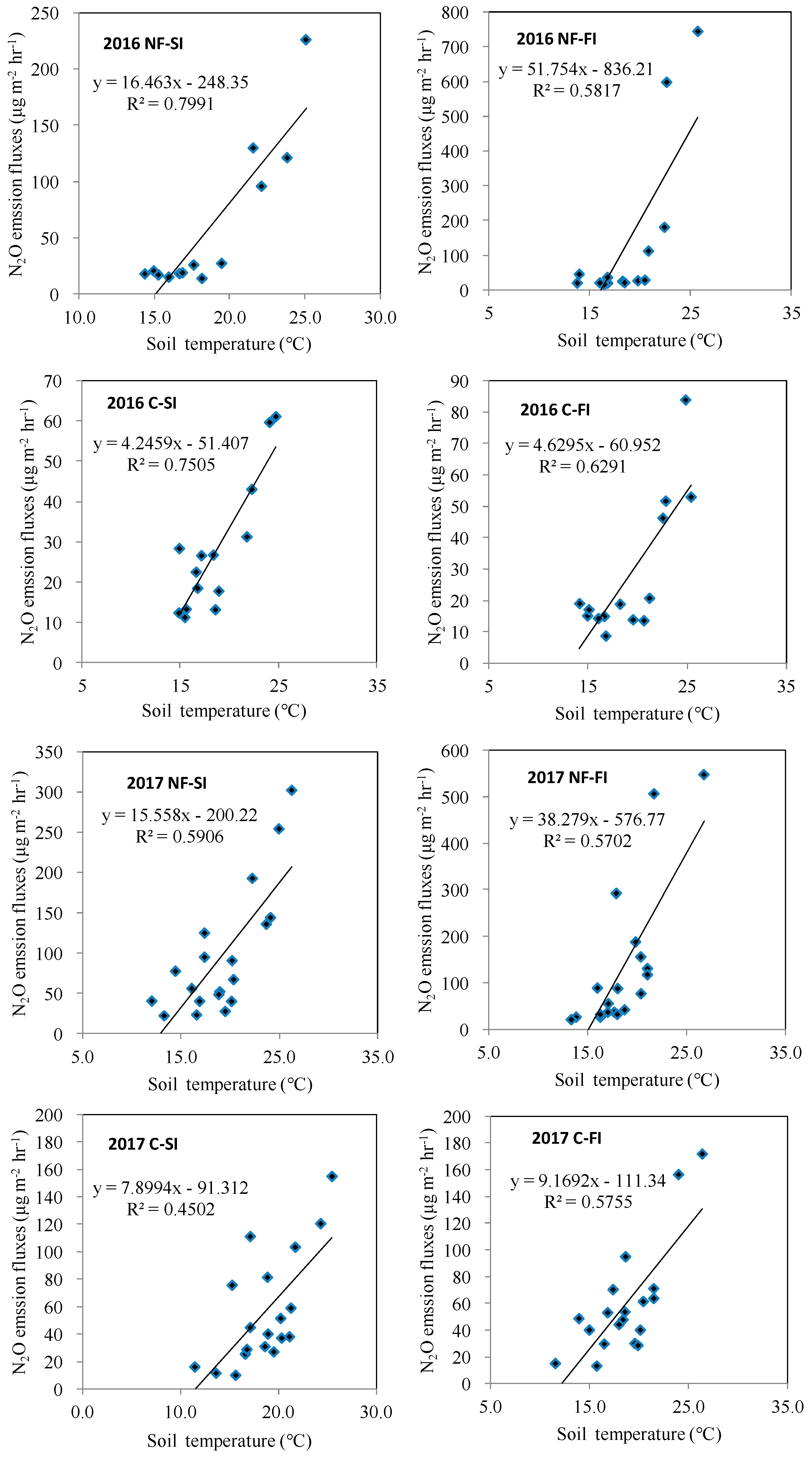Sprinkler Irrigation Is Effective in Reducing Nitrous Oxide Emissions from a Potato Field in an Arid Region: A Two-Year Field Experiment
Abstract
:1. Introduction
2. Experiments
2.1. Description of Study Site
2.2. Experimental Design and Field Management
2.3. Irrigation Management
2.4. Sampling and Analysis of N2O
2.5. Soil Analysis
2.6. Calculation Method of the N2O Emission
2.7. Data Statistics and Analysis
3. Results
3.1. Changes in Precipitation and Temperature
3.2. Relationship between Variations in N2O Emission Fluxes and Moisture or Temperature in Sprinkler-Irrigated and Flood-Irrigated Soils
3.3. Soil Physicochemical Analysis for both Sprinkler and Flood Irrigation Systems
3.4. Cumulative N2O Emissions, Emission Factor, and Emission Intensities under Both Irrigation Systems
4. Discussion
4.1. Seasonal Variation of N2O Emissions for the Two Irrigation Systems
4.2. N2O Emission Fluxes in Fertilized and Control Soils with Sprinkler Irrigation and Flood Irrigation
4.3. Potential of Mitigating N2O Emissions using the Two Irrigation Systems
5. Conclusions
Author Contributions
Funding
Acknowledgments
Conflicts of Interest
References
- Schilt, A.; Brook, E.J.; Bauska, T.K.; Baggenstos, D.; Fischer, H.; Joos, F.; Petrenko, V.V.; Schaefer, H.; Schmitt, J.; Severinghaus, J.P.; et al. Isotopic constraints on marine and terrestrial N2O emissions during the last deglaciation. Nature 2014, 516, 234–237. [Google Scholar] [CrossRef] [PubMed]
- IPCC. Contribution of Working Group I to the Fifth Assessment Report of the Intergovernmental Panel on Climate Change. In Climate Change 2013: The Physical Science Basis; Stocker, T.F., Qin, D., Plattner, G.K., Tignor, M., Allen, S.K., Boschung, J., Nauels, A., Xia, Y., Bex, V., Midgley, P.M., Eds.; Cambridge University Press: Cambridge, UK; New York, NY, USA, 2013. [Google Scholar]
- Robertson, G.P.; Paul, E.A.; Harwood, R.R. Greenhouse gases in intensive agriculture: Contributions of individual gases to the radiative forcing of the atmosphere. Science 2000, 289, 1922–1925. [Google Scholar] [CrossRef]
- Xie, B.; Gu, J.; Yu, J.; Han, G.; Zheng, X.; Xu, Y.; Lin, H. Effects of N fertilizer application on soil N2O emissions and CH4 uptake: A two-year study in an apple orchard in Eastern China. Atmosphere 2017, 8, 181. [Google Scholar] [CrossRef]
- Liu, H.J.; Kang, Y.H.; Yao, S.M.; Sun, Z.Q.; Liu, S.P.; Wang, Q.G. Field evaluation on water productivity of winter wheat under sprinkler or surface irrigation in the North China Plain. Irrig. Drain. 2013, 62, 37–49. [Google Scholar] [CrossRef]
- Naghedifar, S.M.; Ziaei, A.N.; Ansari, H. Simulation of irrigation return flow from a Triticale farm under sprinkler and furrow irrigation systems using experimental data: A case study in arid region. Agric. Water Manag. 2018, 210, 185–197. [Google Scholar] [CrossRef]
- Sanz-Cobena, A.; Lassaletta, L.; Aguilera, E.; del Prado, A.; Garnier, J.; Billen, G.; Iglesias, A.; Sánchez, B.; Guardia, G.; Abalos, D.; et al. Strategies for greenhouse gas emissions mitigation in Mediterranean agriculture: A review. Agric. Ecosyst. Environ. 2017, 238, 5–24. [Google Scholar] [CrossRef]
- Qi, L.; Niu, H.D.; Zhou, P.; Jia, R.J.; Gao, M. Effects of Biochar on the net greenhouse gas emissions under continuous flooding and water-saving irrigation conditions in paddy soils. Sustainability 2018, 10, 1403. [Google Scholar] [CrossRef]
- Ezequiel, S.; Antonio, P.D.C.; Tarlei, A.B.; José, A.F.; Richard, K.; Bruno, M. Test methods for characterising the water distribution from irrigation sprinklers: Design, evaluation and uncertainty analysis of an automated system. Biosyst. Eng. 2018, 169, 42–56. [Google Scholar]
- Lorenzo, D.M.; Martina, M.; Alex, C.B.; Tiago, A.K.; Cleber, M.A. Classification of rice grains of lowland cultivars grown under flood irrigation and sprinkler irrigation. Eng. Agric. 2018, 38, 599–605. [Google Scholar]
- José, C.; Eva, T.M.; Francisco, M. Sprinkler Irrigation Frequency Affects Maize Yield Depending on Irrigation Time. Agron. J. 2018, 110, 1862–1873. [Google Scholar]
- Zapata, N.; Robles, O.; Playán, E.; Paniagua, P.; Romano, C.; Salvadorb, R.; Montoya, F. Low-pressure sprinkler irrigation in maize: Differences in water distribution above and below the crop canopy. Agric. Water Manag. 2018, 203, 353–365. [Google Scholar] [CrossRef]
- Laura, S.M.; Augusto, A.; Alejandro, B.; Lourdes, G.T.; Antonio, V. Influence of drip and furrow irrigation systems on nitrogen oxide emissions from a horticultural crop. Soil Biol. Biochem. 2008, 40, 1698–1706. [Google Scholar]
- Li, J.; Zhang, J.; Ren, L. Water and nitrogen distribution as affected by fertigation of ammonium nitrate from a point source. Irrig. Sci. 2003, 22, 19–30. [Google Scholar]
- Vázquez, N.; Pardo, A.; Suso, M.L.; Quemada, M. A methodology for measuring drainage and nitrate leaching in unevenly irrigated vegetable crops. Plant Soil 2005, 269, 297–308. [Google Scholar] [CrossRef]
- Davidson, E.A. Fluxes of nitrous oxide and nitric oxide from terrestrial ecosystems. In Microbial Production and Consumption of Greenhouse Gases: Methane, Nitrous Oxides and Halomethanes; Rogers, J.E., Whitman, W.B., Eds.; American Society for Microbiology: Washington, DC, USA, 1991; pp. 219–235. [Google Scholar]
- Granli, T.; Bockman, O.C. Nitrogen oxide from agriculture. Norw. J. Agric. Sci. 1994, 12, 7–127. [Google Scholar]
- Guardia, G.; Cangani, M.T.; Andreu, G.; Sanz-Cobena, A.; García-Marco, S.; Álvarez, J.M.; Recio-Huetos, J.; Vallejo, A. Effect of inhibitors and fertigation strategies on GHG emissions, NO fluxes and yield in irrigated maize. Field Crop. Res. 2017, 204, 135–145. [Google Scholar] [CrossRef]
- Sánchez-Martín, L.; Vallejo, A.; Dick, J.; Skiba, U.M. The influence of soluble carbon and fertilizer nitrogen on nitric oxide and nitrous oxide emissions from two contrasting agricultural soils. Soil Biol. Biochem. 2008, 40, 142–151. [Google Scholar] [CrossRef]
- Sánchez-Martin, L.; Meijide, A.; Garcia-Torres, L.; Vallejo, A. Combination of drip irrigation and organic fertilizer for mitigating emissions of nitrogen oxides in semi-arid climate. Agric. Ecosyst. Environ. 2010, 137, 99–107. [Google Scholar] [CrossRef]
- Guardia, G.; Tellez-Rio, A.; García-Marco, S.; Martin-Lammerding, D.; Tenorio, J.L.; Ibáñez, M.Á.; Vallejo, A. Effect of tillage and crop (cereal versus legume) on greenhouse gas emissions and Global Warming Potential in a non-irrigated Mediterranean field. Agric. Ecosyst. Environ. 2016, 221, 187–197. [Google Scholar] [CrossRef]
- Fentabil, M.M.; Nichol, C.F.; Neilsen, G.H.; Hannam, K.D.; Neilsen, D.; Forge, T.A.; Jones, M.D. Effect of micro-irrigation type, N-source and mulching on nitrous oxide emissions in a semi-arid climate: An assessment across two years in a Merlot grape vineyard. Agric. Water Manag. 2016, 171, 49–62. [Google Scholar] [CrossRef]
- David, C.; Lemke, R.; Helgason, W.; Farrell, R.E. Current inventory approach overestimates the effect of irrigated crop management on soil-derived greenhouse gas emissions in the semi-arid Canadian Prairies. Agric. Water Manag. 2018, 208, 19–32. [Google Scholar] [CrossRef]
- Diego, A.; Alberto, S.C.; Gemma, A.; Antonio, V. Rainfall amount and distribution regulate DMPP effects on nitrous oxide emissions under semi-arid Mediterranean conditions. Agric. Ecosyst. Environ. 2017, 238, 36–45. [Google Scholar]
- Soil Survey Staff. Keys to Soil Taxonomy, 6th ed.; USDA: Washington, DC, USA, 1992.
- Yang, W.Z.; Yang, M.D.; Wen, H.Y.; Jiao, Y. Global Warming Potential of CH4 uptake and N2O emissions in saline–alkaline soils. Atmos. Environ. 2018, 191, 172–180. [Google Scholar] [CrossRef]
- Jiao, Y.; Hou, J.H.; Zhao, J.H.; Yang, W.Z. Cropland age from grassland conversion to cropland affects nitrous oxide emission. Acta Agric. Scand. 2015, 65, 566–574. [Google Scholar] [CrossRef]
- Aulakh, M.S.; Khera, T.S.; Doran, J.W. Yields and Nitrogen Dynamics in a Rice–Wheat System Using Green Manure and Inorganic Fertilizer. Soil Sci. Soc. Am. J. 2000, 64, 1867–1876. [Google Scholar] [CrossRef]
- Lim, S.S.; Choi, W.J. Changes in microbial biomass, CH4 and CO2 emissions, and soil carbon content by fly ash co-applied with organic inputs with contrasting substrate quality under changing water regimes. Soil Biol. Biochem. 2014, 68, 494–502. [Google Scholar] [CrossRef]
- Adviento-Borbe, M.A.A.; Linquist, B. Assessing fertilizer N placement on CH4 and N2O emissions in irrigated rice systems. Geoderma 2016, 266, 40–45. [Google Scholar] [CrossRef]
- Kallenbach, C.M.; Rolston, D.E.; Horwath, W.R. Cover cropping affects soil N2O and CO2 emissions differently depending on type of irrigation. Agric. Ecosyst. Environ. 2010, 137, 251–260. [Google Scholar] [CrossRef]
- Firestone, M.K.; Davidson, E.A. Microbial basin of NO and N2O production and consumption in soil. In Exchange of Trace Gases Between Terrestrial Ecosystem and the Atmosphere; Andreae, M.O., Schimel, D.S., Eds.; Wiley: London, UK, 1989; pp. 7–21. [Google Scholar]
- Kang, S.C.; Eltahir, E.A.B. North China Plain threatened by deadly heatwaves due to climate change and irrigation. Nat. Commun. 2018, 9, 2894. [Google Scholar] [CrossRef]
- Sharpe, R.R.; Harper, L.A. Ammonia and nitrous oxide emissions from sprinkler irrigation applications of swine effluent. J. Environ. Qual. 1997, 26, 1703–1706. [Google Scholar] [CrossRef]
- Liu, H.J.; Kang, Y.H. Effect of sprinkler irrigation on microclimate in the winter wheat field in the North China Plain. Agric. Water Manag. 2006, 84, 3–19. [Google Scholar] [CrossRef]
- Sun, Z.Q.; Kang, Y.H.; Jiang, S.F. Effects of water application intensity, drop size and water application amount on the characteristics of topsoil pores under sprinkler irrigation. Agric. Water Manag. 2008, 95, 869–876. [Google Scholar] [CrossRef]
- Wang, X.J.; Wei, C.Z.; Zhang, J.; Dong, P.; Wang, J.; Zhu, Q.C.; Wang, J.X. Effects of irrigation mode and N application rate on cotton field fertilizer N use efficiency and N losses. Chin. J. Appl. Ecol. 2012, 23, 2751–2758. [Google Scholar]
- Lv, G.H.; Kang, Y.H.; Li, L.; Wan, S.Q. Effect of irrigation methods on root development and profile soil water uptake in winter wheat. Irrig. Sci. 2010, 28, 387–398. [Google Scholar] [CrossRef]
- Vallejo, A.; García-Torres, L.; Diez, J.A.; Arce, A.; López-Fernández, S. Comparison of N losses (NO3, N2O, NO) from surface applied, injected or amended (DCD) pig slurry of an irrigated soil in a Mediterranean climate. Plant Soil 2005. 272, 313–325.
- Álvaro-Fuentes, J.; Arrúe, J.L.; Cantero-Martínez, C.; Isla, R.; Plaza-Bonilla, D.; Quílez, D. Fertilization scenarios in Sprinkler-Irrigated corn under Mediterranean Conditions: Effects on Greenhouse Gas Emissions. Soil Sci. Soc. Am. J. 2016, 80, 662–671. [Google Scholar] [CrossRef]
- Kuang, W.N.; Gao, X.P.; Gui, D.W.; Tenuta, M.; Flaten, D.N.; Yin, M.Y.; Zeng, F.J. Effects of fertilizer and irrigation management on nitrous oxide emission from cotton fields in an extremely arid region of northwestern China. Field Crop. Res. 2018, 229, 17–26. [Google Scholar] [CrossRef]
- Bronson, K.F.; Hunsaker, D.J.; Williams, C.F.; Thorp, K.R.; Rockholt, S.M.; Del Grosso, S.J.; Venterea, R.T.; Barnes, E.M. Nitrogen management affects nitrous oxide emissions under varying cotton irrigation systems in the desert southwest, USA. J. Environ. Qual. 2018, 47, 70–78. [Google Scholar] [CrossRef]
- Xu, Y.X.; Guo, L.P.; Xie, L.Y.; Yun, A.P.; Li, Y.C.; Zhang, X.; Zhao, X.; Diao, T.T. Characteristics of background emissions and emission factors of N2O from major upland fields in China. Sci. Agric. Sin. 2016, 49, 1729–1743. [Google Scholar]
- Cayuela, M.L.; Aguilera, E.; Sanz-Cobena, A.; Adams, D.C.; Abalos, D.; Barton, L.; Ryals, R.; Silver, W.L.; Alfaro, M.A.; Pappa, V.A.; et al. Direct nitrous oxide emissions in Mediterranean climate cropping systems: Emission factors based on a metaanalysis of available measurement data. Agric. Ecosyst. Environ. 2017, 238, 25–35. [Google Scholar] [CrossRef]





| Soil Texture | Soil Depth (cm) | Clay (%) | Silt (%) | Sand (%) | CaCO3 (g kg−1) |
|---|---|---|---|---|---|
| sandy clay loam | 0-30 | 32% ± 0.3 1 | 20 ± 0.2 | 48 ± 0.4 | 8.54 ± 1.5 |
| Treatments 1 | pH | Bulk Density (g cm−3) | Porosity (%) | Organic Carbon (g kg−1) | NH4+-N (mg kg−1) | NO3−-N (mg kg−1) |
|---|---|---|---|---|---|---|
| NF-SI | 8.31 ± 0.02 | 1.24 ± 0.07 | 49.86 ± 2.40 | 3.43 ± 0.36 | 4.40 ± 1.17 | 25.68 ± 4.25 |
| C-SI | 8.29 ± 0.05 | 1.24 ± 0.03 | 49.31 ± 0.32 | 3.82 ± 0.41 | 4.56 ± 1.09 | 25.89 ± 1.53 |
| NF-FI | 8.31 ± 0.03 | 1.27 ± 0.02 | 49.17 ± 0.83 | 3.41 ± 0.38 | 4.62 ± 1.17 | 25.73 ± 7.76 |
| C-FI | 8.32 ± 0.02 | 1.26 ± 0.01 | 50.06 ± 0.78 | 3.38 ± 0.29 | 4.73 ± 1.67 | 24.95 ± 1.58 |
| Year | Treatments | Bulk Density (g cm−3) | Porosity (%) | NH4+-N Content (mg kg−1) | NO3−-N Content (mg kg−1) |
|---|---|---|---|---|---|
| 2016 | NF-FI NF-SI C-FI C-SI | 1.34 ± 0.07 (a) 1.21 ± 0.03 (b) 1.35 ± 0.05 (a) 1.19 ± 0.01 (b) | 48.13 ± 1.40 (a) 49.86 ± 0.53 (b) 49.23 ± 0.62 (c) 52.58 ± 0.75 (d) | 7.09 ± 1.10 (a) 6.46 ± 1.00 (b) 6.64 ± 1.22 (c) 6.08 ± 1.43 (d) | 34.28 ± 1.25 (a) 22.98 ± 1.60 (b) 21.76 ± 1.21 (c) 16.64 ± 1.36 (e) |
| 2017 | NF-FI NF-SI C-FI C-SI | 1.29 ± 0.02 (c) 1.17 ± 0.02 (b) 1.29 ± 0.01 (c) 1.21 ± 0.01 (b) | 50.42 ± 2.30 (e) 55.15 ± 1.80 (f) 50.09 ± 1.20 (c) 53.17 ± 0.38 (d) | 6.95 ± 1.35 (e) 6.25 ± 1.06 (f) 6.76 ± 1.40 (b) 6.21 ± 1.20 (d) | 73.66 ± 2.21 (f) 37.76 ± 1.13 (g) 34.41 ± 2.05 (h) 30.47 ± 1.97 (i) |
| Year | Treatments | Amount of Harvested Product (t ha−1) | Cumulative N2O Emissions (mg m−2) | EF 1 (%) | EI 2 (kg N t−1 Year−1) |
|---|---|---|---|---|---|
| 2016 | NF-FI NF-SI C-FI C-SI | 31.55 ± 4.81 (a) 39.92 ± 0.56 (b) 22.78 ± 1.62 (c) 26.11 ± 3.50 (c) | 373.03 ± 17.82 (a) 150.40 ± 20.01 (b) 76.12 ± 17.82 (c) 74.51 ± 11.31 (c) | 0.76 (a) 0.20 (b) | 1.18 ± 0.70 (a) 0.37 ± 0.09 (b) 0.33 ± 0.12 (b) 0.29 ± 0.09 (b) |
| 2017 | NF-FI NF-SI C-FI C-SI | 29.84 ± 2.28 (a) 39.59 ± 0.86 (b) 22.43 ± 2.37 (c) 25.39 ± 2.95 (c) | 425.12 ± 31 (d) 252.01 ± 40 (e) 180.84 ± 35 (f) 177.05 ± 33 (f) | 0.62 (a) 0.19 (b) | 1.24 ± 0.65 (a) 0.64 ± 0.18 (d) 0.81 ± 0.20 (e) 0.70 ± 0.19 (d) |
© 2019 by the authors. Licensee MDPI, Basel, Switzerland. This article is an open access article distributed under the terms and conditions of the Creative Commons Attribution (CC BY) license (http://creativecommons.org/licenses/by/4.0/).
Share and Cite
Yang, W.; Kang, Y.; Feng, Z.; Gu, P.; Wen, H.; Liu, L.; Jia, Y. Sprinkler Irrigation Is Effective in Reducing Nitrous Oxide Emissions from a Potato Field in an Arid Region: A Two-Year Field Experiment. Atmosphere 2019, 10, 242. https://doi.org/10.3390/atmos10050242
Yang W, Kang Y, Feng Z, Gu P, Wen H, Liu L, Jia Y. Sprinkler Irrigation Is Effective in Reducing Nitrous Oxide Emissions from a Potato Field in an Arid Region: A Two-Year Field Experiment. Atmosphere. 2019; 10(5):242. https://doi.org/10.3390/atmos10050242
Chicago/Turabian StyleYang, Wenzhu, Yuehu Kang, Zhiwen Feng, Peng Gu, Huiyang Wen, Lijia Liu, and Yongqin Jia. 2019. "Sprinkler Irrigation Is Effective in Reducing Nitrous Oxide Emissions from a Potato Field in an Arid Region: A Two-Year Field Experiment" Atmosphere 10, no. 5: 242. https://doi.org/10.3390/atmos10050242
APA StyleYang, W., Kang, Y., Feng, Z., Gu, P., Wen, H., Liu, L., & Jia, Y. (2019). Sprinkler Irrigation Is Effective in Reducing Nitrous Oxide Emissions from a Potato Field in an Arid Region: A Two-Year Field Experiment. Atmosphere, 10(5), 242. https://doi.org/10.3390/atmos10050242




